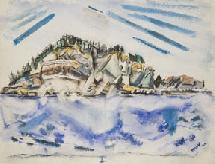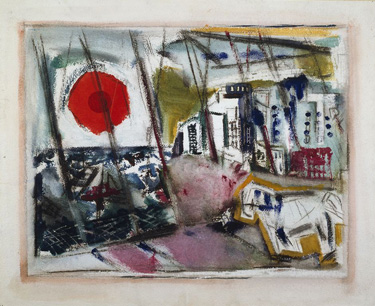In today’s Wall Street Journal I report on two out-of-town musical-comedy revivals, Goodspeed Musicals’ Show Boat and the Ogunquit Playhouse’s The Music Man. Here’s an excerpt.
* * *
Everybody wants to do “Show Boat.” Who wouldn’t? Any musical whose score is festooned with songs as potent as “Can’t Help Lovin’ Dat Man,” “Make Believe,” “Ol’ Man River” and “Why Do I Love You?” is by definition a crowd-pleaser. But “Show Boat” is also a three-hour-long extravaganza whose elaborate sets include a 19th-century Mississippi River excursion boat and a fancy Chicago nightclub. That spells big bucks, and now that America’s financially beleaguered regional theater companies are increasingly turning to small-scale productions of sure-fire shows, revivals of “Show Boat” have become fewer and farther between. When Arlington’s Signature Theatre sought in 2009 to beat the shifting odds with a slimmed-down version of the Jerome Kern-Oscar Hammerstein classic, the unhappy result was a cramped-looking, ill-sung staging that failed to convey the show’s near-operatic feel.
 Now Goodspeed Musicals has triumphantly solved the “Show Boat” problem. Rob Ruggiero’s heart-lifting new revival succeeds in shoehorning “Show Boat” onto a very small stage without compromising its expansive spirit in any way. The cast is superior, the direction and choreography excitingly immediate, and Michael Schweikardt’s compact yet rich-looking sets deserve a prize for sheer ingenuity. Moreover, this “Show Boat” benefits immeasurably from being performed in Goodspeed’s century-old 398-seat auditorium. Not only does it overlook the Connecticut River, but the interior is a dead ringer for the inside of a turn-of-the-century show boat, and Mr. Ruggiero has taken maximum advantage of that serendipitous fact by staging “Show Boat” in such a way as to make you feel as though you’re actually on board the Cotton Blossom. No sooner do you see Joe (David Aron Damane) polishing the brass rails of the balcony than you surrender happily to the illusion, and from then on you know you’re in the best of hands….
Now Goodspeed Musicals has triumphantly solved the “Show Boat” problem. Rob Ruggiero’s heart-lifting new revival succeeds in shoehorning “Show Boat” onto a very small stage without compromising its expansive spirit in any way. The cast is superior, the direction and choreography excitingly immediate, and Michael Schweikardt’s compact yet rich-looking sets deserve a prize for sheer ingenuity. Moreover, this “Show Boat” benefits immeasurably from being performed in Goodspeed’s century-old 398-seat auditorium. Not only does it overlook the Connecticut River, but the interior is a dead ringer for the inside of a turn-of-the-century show boat, and Mr. Ruggiero has taken maximum advantage of that serendipitous fact by staging “Show Boat” in such a way as to make you feel as though you’re actually on board the Cotton Blossom. No sooner do you see Joe (David Aron Damane) polishing the brass rails of the balcony than you surrender happily to the illusion, and from then on you know you’re in the best of hands….
In addition to being fine actors, everyone in the cast can sing, not just well enough but outstandingly. Top honors go to the warm and affecting Magnolia of Sarah Uriarte Berry, with the mahogany-voiced Mr. Damane no more than half a step behind….
Unlike “Show Boat, the perennially popular “The Music Man” is all but impossible to foul up. While a creative director can do imaginative things with Meredith Willson’s best-known show, as Bill Rauch’s non-traditional high-concept Oregon Shakespeare Festival revival proved two seasons ago, all you really need to do to make “The Music Man” work is hire two good stars, put together a strong chorus and play everything straight. Do that and you’re sure to send ’em home happy. The Ogunquit Playhouse’s new “Music Man,” which makes use of Thomas Lynch’s old-fashioned storybook sets for Susan Stroman’s 2000 Broadway revival, is unabashedly traditional in just about every way, starting with Ray Roderick’s briskly efficient staging. The result is a solid and satisfying summer-resort musical, just the kind of show that will delight the kids (and their parents) after a long, hard day on the beach….
* * *
Read the whole thing here.
Archives for August 5, 2011
TT: Whatever happened to John Marin?
A couple of weeks ago I went to the Portland Museum of Art to see its exhibition of paintings and works on paper by John Marin, one of my favorite American modernists. A similar show is currently on view at Atlanta’s High Museum. In my “Sightings” column for today’s Wall Street Journal I explore the question of why Marin, who was for much of the twentieth century one of America’s leading artists, is no longer widely known. Here’s an excerpt.
* * *
 Sooner or later, everyone who writes about John Marin gets around to mentioning the 1948 Look magazine poll of 68 critics, curators and museum directors who, when asked to name America’s greatest living painters, put him at the top of the list. Five years later, the headline of Marin’s New York Times obituary described him as “Artist Considered by Many as ‘America’s No. 1 Master’.” No less a highbrow than the art critic Clement Greenberg concurred, predicting that Marin and Jackson Pollock would “compete for recognition as the greatest American painter of the 20th century.”
Sooner or later, everyone who writes about John Marin gets around to mentioning the 1948 Look magazine poll of 68 critics, curators and museum directors who, when asked to name America’s greatest living painters, put him at the top of the list. Five years later, the headline of Marin’s New York Times obituary described him as “Artist Considered by Many as ‘America’s No. 1 Master’.” No less a highbrow than the art critic Clement Greenberg concurred, predicting that Marin and Jackson Pollock would “compete for recognition as the greatest American painter of the 20th century.”
So why does Marin so often get the “John Who?” treatment? For it’s better than even money that unless you happen to be a connoisseur of American modernism or an art-history major, his name is unknown to you. It’s been 21 years since a major American museum last put together a full-scale retrospective of his work. New York’s Museum of Modern Art owns 25 Marins–but not a single one of them is currently on view.
To be sure, Marin has his share of passionate admirers, and important Marin exhibitions have just been simultaneously mounted by two medium-sized American museums, Maine’s Portland Museum of Art (up through Oct. 10) and Atlanta’s High Museum (up through Sept. 11). The catalogues of both shows are highly impressive pieces of work, and between them they make a powerful case for taking a second look at Marin–but their authors are quick to admit that such a look is now necessary, since Marin has in recent years fallen into something not far removed from obscurity. Indeed, the foreword to Portland’s “John Marin: Modernism at Midcentury” catalogue goes so far as to describe him as “the missing man among the pantheon of great American modernists.”
 As I strolled through the Portland show the other day, I found myself wondering yet again how so explosively vital a painter could have dropped off the scope. A bold colorist who viewed the American landscape through the kaleidoscopic prism of cubism, Marin conveyed with identical precision and sympathy the nervous angularity of lower Manhattan (“City Movement,” 1940) and the ceaseless turmoil of the waves that break on the coast of Maine (“Outer Sand Island, Maine,” 1936). Like all prolific artists, he was uneven in inspiration, but having seen dozens of his watercolors–he painted some 2,500 of them–I’m struck by how many are not just effective but indelibly memorable….
As I strolled through the Portland show the other day, I found myself wondering yet again how so explosively vital a painter could have dropped off the scope. A bold colorist who viewed the American landscape through the kaleidoscopic prism of cubism, Marin conveyed with identical precision and sympathy the nervous angularity of lower Manhattan (“City Movement,” 1940) and the ceaseless turmoil of the waves that break on the coast of Maine (“Outer Sand Island, Maine,” 1936). Like all prolific artists, he was uneven in inspiration, but having seen dozens of his watercolors–he painted some 2,500 of them–I’m struck by how many are not just effective but indelibly memorable….
* * *
Read the whole thing here.
TT: Almanac
“Whenever anything is being accomplished, it is being done, I have learned, by a monomaniac with a mission.”
Peter F. Drucker, Adventures of a Bystander
